It’s Day 29 in the BBA Challenge and we finally made it to the end of the Ps. Today, we’re making Pugliese, a rustic Italian bread similar to ciabatta.
Ciabatta originated in the Lake Como region of Lombardy (northern Italy) whereas Pugliese refers to the southeastern Italian region of Apula (Puglia in Italian). Both of these breads fall in the rustic category because the hydration is in excess of 65 percent. The difference is that Pugliese is usually baked in rounds rather than in the slipper shape of ciabatta. Pugliese utilizes a blend of durum and regular bread flours. I made my version with a combination of 50 percent durum and 50 bread flour.
I really like the texture of this bread. The crumb is just marvelous! For a semolina bread, I think I like Pane Siciliano better, but this one is still good, especially as a dipping bread. It goes really well with Italian cuisine. In fact, I decided to make some spaghetti to go with the bread rather than the other way around.
The dough can also be used for pizza. I was planning on making one loaf of bread and using the rest of the dough for pizza, but changed my mind at the last minute. I should’ve gone with my first thought because I ended up burning the second loaf. I fell asleep. Lesson learned: Don’t try to make bread when you’re exhausted.
Pugliese
Makes: Two 1-pound loaves (or use part or all of the dough to make pizza)
Ingredients:
- 2 cups biga
- 2 1/4 cups fancy or extra fancy durum flour and unbleached bread flour, in any combination (such as 50-50 blend)
- 1 1/2 teaspoons salt
- 1 teaspoon instant yeast
- 1/4 cup mashed potatoes (optional)
- 1 to 1 1/8 cups water, lukewarm
- Semolina flour or cornmeal for dusting
Making the Biga
For detailed instructions on making the biga, refer to the Italian Bread post.
Mixing the Dough
Remove the biga from the refrigerator 1 hour before you plan to make the bread. Cut it into about 10 small pieces. Cover the pieces with plastic wrap and let them sit to take off the chill.
Stir (or mix) together the flour, salt, and yeast. Add the biga pieces, mashed potatoes, and water.
Mix until the ingredients form a wet, sticky ball. Add more water or flour as necessary. Switch to the dough hook and mix for 4 to 5 minutes, or as long as it takes to create a smooth, sticky dough. The dough should clear the sides of the bowl but stick to the bottom of the bowl. Add flour or water as necessary. The dough will be very sticky. Keep in mind that the wetter the dough, the better the final bread will be.
Stretch-and-Fold Method
Make a bed of flour on the counter about 8 inches square. Use a spatula dipped in water to transfer the dough to the bed of flour.
Then perform the stretch-and-fold method as shown in the Ciabatta post (refer to page 138 in book) or for additional instruction, view a video of the stretch and fold method
Mist the top of the dough with spray oil, dust with flour, and loosely cover with plastic wrap. Let it rest for 30 minutes.
Repeat the stretch-and-fold method and mist with spray oil again, dust with additional flour and cover. Let it rest for another 30 minutes. Do this for a total of three times.
Lightly oil a large bowl and transfer the dough (using a spatula dipped in water) to the bowl. Cover the bowl with plastic wrap and let the dough ferment for 2 hours.
Shaping the Loaves
Dust the counter with flour. Remove the plastic wrap and with floured hands and a scraper dipped in flour, transfer the dough to the counter. Try not to degas the dough any more than necessary.
Using a metal pastry scraper dipped in flour, cut the dough into 2 pieces.
Dip your hands in flour and gently shape the dough pieces into 2 boules (Page 72).
Places the boules seam-side down, on the counter for a few minutes.
Proofing the Loaves
Prepare 2 proofing bowls and coat them with spray oil and generously dust the surface of the cloths with flour. You don’t need any special equipment for this part. I just used 2 mixing bowls. Gently transfer the dough, seam-side up, into the bowls.
Mist the top of the dough with spray oil and cover the bowls with the flaps of the cloth. My cloths weren’t big enough so I place another cloth on top.
Proof the loaves at room temperature for 60 to 90 minutes, or until the dough has expanded to about 1 1/2 times it original size.
Preparing the oven for hearth baking
Preheat the oven to 500 degrees. For detailed instructions on hearth baking with a steam pan, refer to the post on Pain À l’Ancienne Baguettes.
I decided to use my La Cloche for this part instead of using the steam pan. Since the loaves are round, they fit nicely inside it. I haven’t been able to use my La Cloche with the BBA baguettes or batards so here was my chance.
To prepare the cloche, I greased the bottom with coconut oil and sprinkled it with cornmeal. Then soaked the domed lid in water for about 15 minutes while I preheated the oven to 450 degrees.
Then, I gently transferred the dough for one loaf into the La Cloche by carefully turning the bowl over, lifting off the bowl, and peeling off the cloth.
I scored the loaves with a pound (#) pattern using a serrated knife. I find it easier and more efficient than using a lame.
Baking the Loaves
Bake the loaves for 15 minutes, check them and continue baking for another 5 to 15 minutes, or until the breads are a deep golden brown.
Remove the loaves from the oven and transfer to a cooling rack. The crusts should soften a little as they cool. Allow the loaves to cool for at least 40 minutes before slicing or serving.
Here is the loaf that wasn’t burned. Thank goodness!
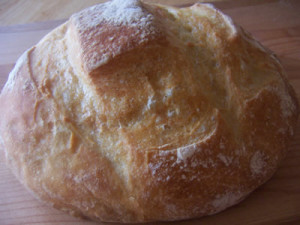
I’m submitting this bread to YeastSpotting, a bread roundup hosted by Susan of Wild Yeast. Please visit Wild Yeast to view all of the lovely breads in the roundup.
This bread tastes really good dipped in olive oil with freshly ground black pepper.
The next series in the Bread Baker’s Apprentice Challenge is Sourdough Breads.
Happy Baking!
Cathy
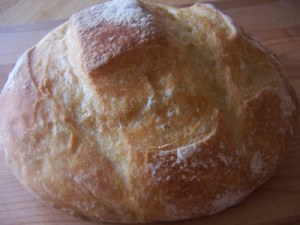
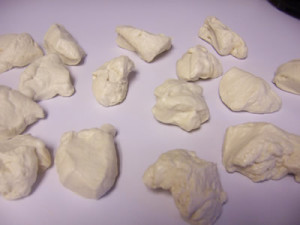
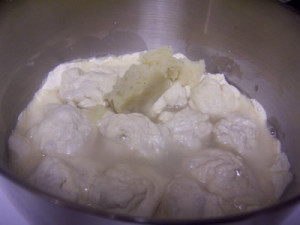

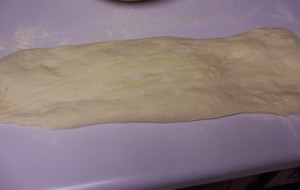
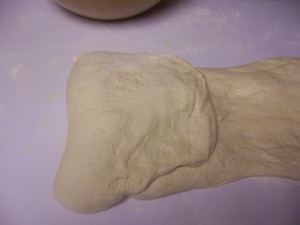
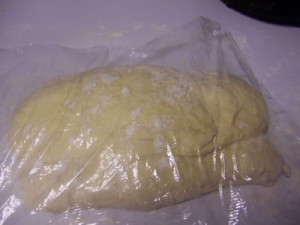
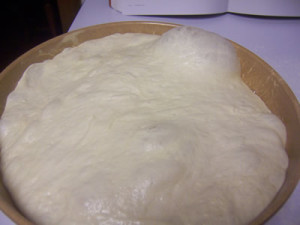
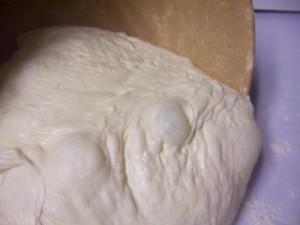


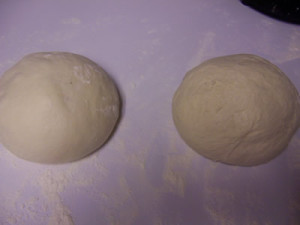


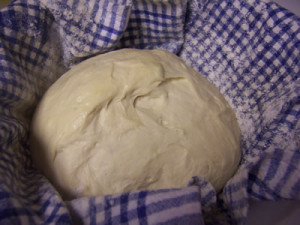
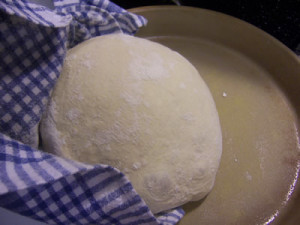
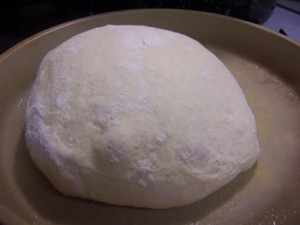
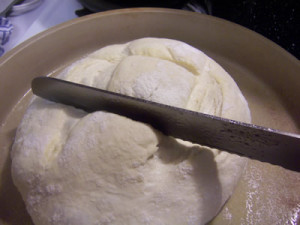
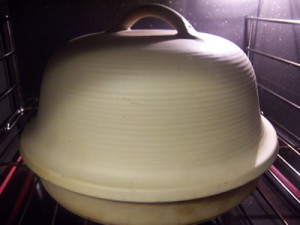
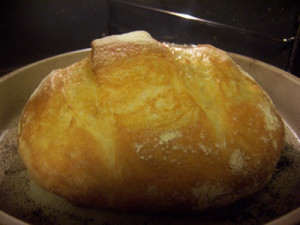
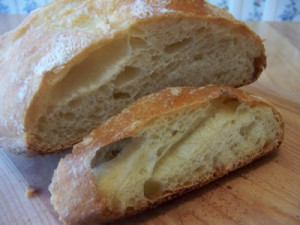
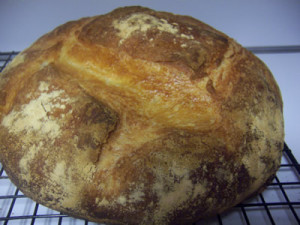
Kelly says
The unburned loaf is beautiful! Wow, what a crumb- looks perfect.
Cathy (breadexperience) says
Thanks Kelly! I’m glad I didn’t burn both loaves. That would’ve really been a bummer.
Cindy says
Wow, beautiful golden crust. Does the cloche help with the browned crusty exterior?
Cathy (breadexperience) says
Thanks Cindy! Yes, the La Cloche definitely helps with the browned exterior. I have trouble getting the loaves to brown (without burning) using the steam pan method but the La Cloche works great!
Mags says
I just finished with the potato rosemary bread and I don’t know if I want to move forward. IT WAS PERFECT and I can’t imagine finding another bread I like more!
But if you say the pugliese is good in its own right, I’ll believe you.
Cathy (breadexperience) says
Mags, I wasn’t sure I wanted to make this bread either. The Pugliese is good especially for a rustic bread. However, it does not compare to the Potato Rosemary Bread in my book. I enjoy making rustic breads, but I prefer eating softer breads like the potato rosemary bread not to mention the aroma was heavenly. You could always make the Pugliese dough into pizza. I almost did that.
Frieda says
So that’s a La Cloche…wow! You had quite an adventure there, huh? Turned out beautiful, Cathy!
Cathy (breadexperience) says
Thanks Frieda! Yes, it was quite an adventure. Just glad I didn’t burn the house down. For goodness sake!
Chris says
I’ve been wondering so much about the La Cloche’s. That loaf looks GBD, as I call it around here. (Golden Brown & Delicious) Nice work Cathy.
Moogie says
Cathy, Thanks for stopping by my blog. Your pictures look great! I have been half-way thinking of buying this bread book, not to do the bread challenge, that’s to big of a commitment right now. But for my own experience, about once or twice a month.
By the way, I live in Hoschton, Ga. Small world.
Cathy (breadexperience) says
Thanks Chris! I really like using the La Cloche. It definitely improves the texture and color of the bread. GBD – I like that!
Cathy (breadexperience) says
Hi Moogie! I think you should get the book. You won’t be disappointed. I actually got the book about a year before this challenge started and had made a few of the breads. That’s why I was excited about the challenge.
It is a small world. How about that!
Cristie says
I’ve made Pugliese before, so sorry you lost the last loaf! It’s so many steps. But your other loaf looks PERFECT, just like all your other breads. I wish I lived near you and I’d be in your classes.
Cathy (breadexperience) says
Thanks Cristie! At least I got to enjoy one of the loaves. I wish I had time to teach a bread-baking class. I definitely enjoy blogging about it.
oggi says
Wow, it’s beautiful specially the crumb.
Cathy (breadexperience) says
Thanks oggi! It’s delicious!
misterrios says
Beautiful loaves. Even the burnt one is photogenic. Too bad it’s not edible. And the holes are amazing in the crumb shot. Am now looking forward to making this one.
(By the way, the word verification is cloche! Awesome coincidence.)
Cathy (breadexperience) says
Thanks misterrios! I really liked this one for a rustic bread. I’ve eaten almost the whole loaf myself. You will enjoy it!
Mimi says
Sorry you burned your second loaf. I hate kitchen mishaps! The first loaf looks great!!
Cathy (breadexperience) says
Thanks Mimi! I’ve definitely had my share of kitchen mishaps. Sure I’ll have some more. I guess it’s how you handle them that matters. 🙂
Joanne says
Wow that looks JUST like the Italian bread that my grandmother used to buy from the local italian bakery. Great holes and texture! I am getting this cookbook for Christmas and can’t wait!
Cathy (breadexperience) says
Thanks Joanne! I really liked this bread dipped in olive oil with herbs.
I’m glad you’re getting the book. It is a great book! You’ll enjoy it!
Anonymous says
Where are the measurements and ingredients? I would love to make this bread.
Cathy (breadexperience) says
Hi Anonymous,
Pugliese is a great bread! You can find the formula in the Bread Baker’s Apprentice by Peter Reinhart. I’m sure you understand, but we were unable to post the formulas due to copyright issues.
Anonymous says
Hi,
I just bought an Emile Henry dutch oven. Can I use that instead of the La Cloche?
Nice bread by the way!
Cathy (breadexperience) says
Hi Anonymous! Thanks for stopping by. I usually use a dutch oven for no knead breads. I’m not sure how it would do with this bread because it needs to expand a good bit. You can certainly try it and see how it turns out. Or, you can bake it freeform on a baking stone with a steam pan underneath.
Cathy (breadexperience) says
Actually after further reflection, I bet this bread would work in the Emile Henry dutch oven. I’d be interested to see how it turns out.
RodinkasJoy says
You know, Cathy, le Sorelle Simili bake their Pugliese bread for a full hour : 20 mins at 500° and then the rest at 390°! Your “burnt” loaf is what gli Pugliese like, apparently!
Cathy W. says
Very interesting… thanks for sharing.